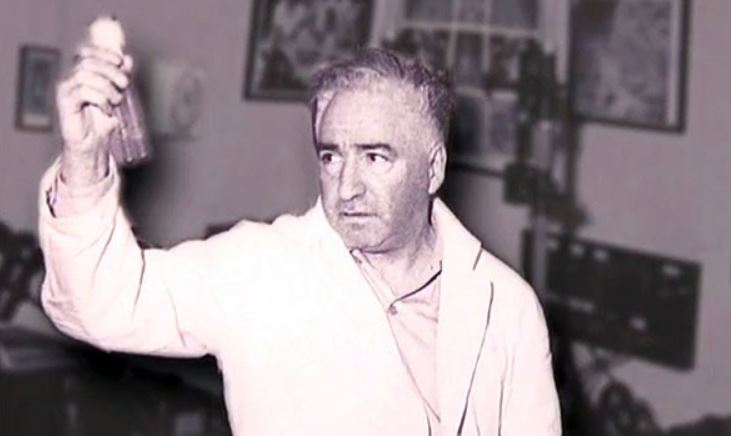Benjamin Garland
Daily Stormer
March 15, 2017
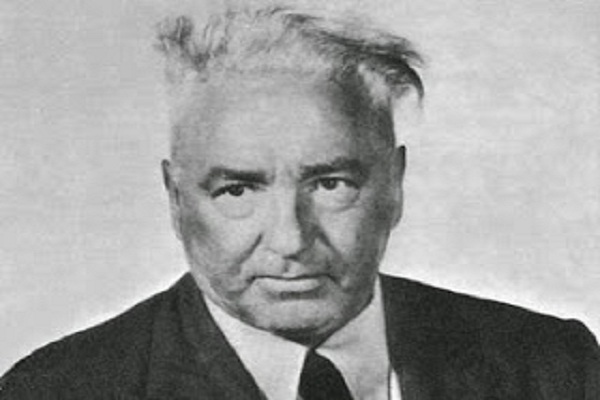
Wilhelm Reich
Part 1, Part 2, Part 3, Part 4, Part 6, Part 7, Part 8, Part 9
“Reich antedated the attempt of the Frankfurt School to amalgamate sociology (Marx) and psychology (Freud).” – John Murray Cuddihy1
Wilhelm Reich was born in 1897 to wealthy Jewish parents in the Eastern European province of Galicia, where he would spend much of his child and teenage years.
His “conscious sexuality” was awakened, he would later write, at the age of four, through “contact with the maids.”2
He eavesdropped on one of them having sex when he was four and a half years old, and reportedly felt “erotic sensations of enormous intensity.” Shortly after that, he fondled the family nurse in a bed, and she let him climb upon and attempt to have sex with her.3
He first had actual intercourse with one of the cooks at age eleven and a half, and claimed he had sex with servants from then on “almost every day for years.”4
When he was ten his mother began cheating on his father with his tutor. Reich admitted he got “erotic feelings” watching this through the bedroom door, and even fantasized about joining in: “Once I even considered breaking in on them and demanding that she have intercourse with me too (shame!), threatening that otherwise I would tell Father.”5
When his father began to suspect his mother’s cheating he forced Reich to tell him what was happening. His frightened mother then tried to kill herself, only to be saved by Reich’s father who then beat her “mercilessly” almost daily for the following year, until she finally managed to succeed with suicide, on the third try, when Reich was thirteen.6
Reich’s role in his mother’s death haunted him for the rest of his life.
Four years later, when Reich was seventeen, his father was dead of pneumonia (possibly self-inflicted – or at least Reich thought so).
All of the above comes from Reich’s highly disturbing autobiography, Passion of Youth. Here is a small sample of the innumerable other perversions found in the book:
Since I always bathed with Mother . . . sexual feelings regularly stirred within me and I often attempted to undress Mother with my eyes. . . . Twice I masturbated while consciously fantasizing about my mother . . .
One of our farmhands had a son approximately twenty years old . . . he would lie in front of the house . . . play[ing] with his genitals . . . I enjoyed watching him play with himself and, through this, experienced highly pleasurable sensations. . . .
The sight of urinating stallions, cows, dogs, etc., produced pronounced sexual sensations in me. . . .
One day I grew so excited looking at the animals that I took a whip with a smooth grip, turned it around, and thrust the handle into the vagina of a mare. The animal was surprised at first but then seemed to enjoy it. She spread her legs wide and began to urinate while I had an orgasm . . .
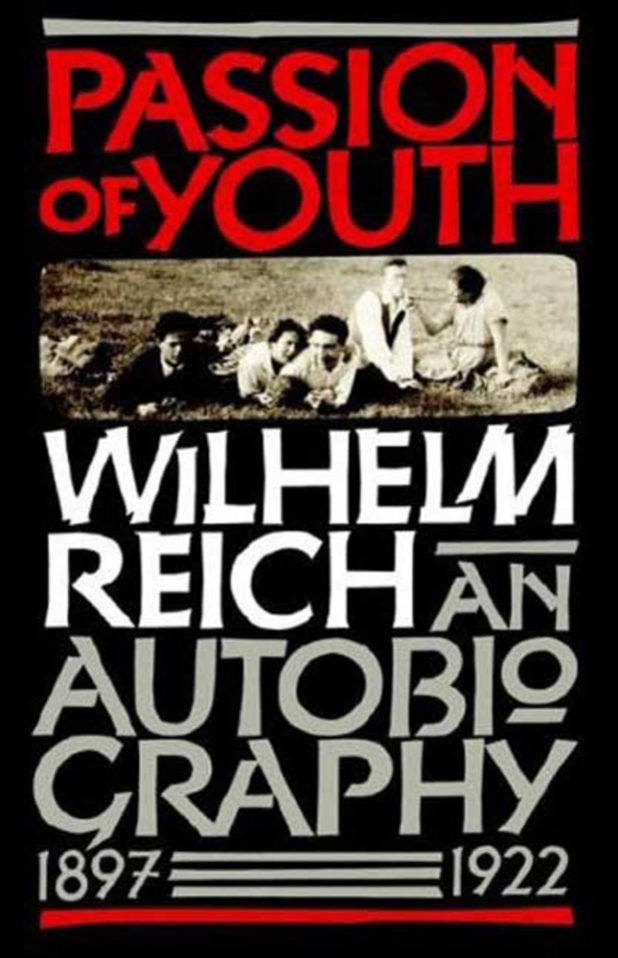
In 1919, after serving in WWI, Reich moved to Vienna, where he met with Sigmund Freud and became the youngest official member of the Viennese Psychoanalytic Society by 20 years.
He began seeing patients and treating them to psychoanalysis (which generally just consists of first diagnosing the patient as ‘neurotic,’ then discovering they have a repressed sexual “fixation” on someone in their immediate family).
Freud believed, or at least taught, that everyone is sexual from birth and goes through “psychosexual stages,” in which their sexual drive, or “libido,” is centered around a specific part of their body. First is the “oral” stage, second is the “anal” stage, and so on, with the final stage being “genital.”
Getting “hung up” in any of these stages causes mental disorders later in life, such as “anal personalities,” according to Freud. Since the final and ideal stage is “genital,” Reich’s theory was that “genital satisfaction” is the key to mental health.
He became obsessed with this idea and began prescribing for patients to have affairs, sleep with prostitutes, and began teaching – even elderly patients – how to masturbate, with detailed advice on how to have strong orgasms (“total orgasm”).
Reich said that “genital stagnation” could result in “heart ailments . . . excessive perspiration, hot flashes and chills, trembling, dizziness, diarrhea, and, occasionally, increased salivation.”7
It’s probably safe to say that this was just a projection of Reich’s own peculiarly perverted nature. He once told a colleague that he felt ill and “saw black before his eyes” after going just two days without orgasm, from which he got immediate relief upon release.8
This obsession with orgasms made Freud and the other psychoanalysts increasingly uncomfortable. He broke with them around the time of the publication of his book, The Function of the Orgasm, in 1927.
He had recently discovered Marx, and now, fusing Marx’s theories with Freud’s, was seeking to apply the lessons of psychoanalysis to society at large, rather than just to individual patients: free the masses from sexual repression and pave the way toward a peaceful, communist utopia.
Now that he was alienated from Freud, he joined the Communist Party of Austria, in 1928, and began helping them agitate for civil war, which they hoped would precipitate a Communist takeover.
In 1929, he founded multiple sex clinics to continue his sex work, using the motto “Free Sexuality Within an Egalitarian Society.”
In 1930, he left Vienna and moved to Berlin, where he again joined with the Communist Party (the largest in Europe).
There he opened up the German Association for Proletarian Sexual Politics (Sex-Pol), and gained many followers. Reich was a very compelling and charismatic speaker; he could gather crowds of up to 20,000 to listen to him preach his radical Sex-Pol doctrine.
These were very turbulent times in Germany: economic depression had caused widespread unemployment, degeneracy was rampant, and the Communists and the National-Socialists were locked in a violent struggle for the heart and soul of the German people, with conflicts in the streets occurring almost daily.

Reich (third from left) with “fellow travelers,” underneath banners reading “Vote Communist!” and “With the Communists Against the Fascists.”
In 1932, an article by Reich was published in the first issue of the journal for the Institute for Social Research (the Jewish “Frankfurt School”). Reich’s fusion of Marx and Freud set the tone for the Institute’s later publications, many of which would end up being highly influential on the “New Left” and “counterculture” that drove the sexual revolution of America and the West during the 1960s and 70s (see part 5).
That same year, he wrote and distributed a pamphlet titled The Sexual Struggle of Youth, in which he encouraged adolescent sexuality to “counter” the pamphlets distributed by the National Socialists, who were promoting sexual morality. Activity such as this put Reich on the Nazis’ radar as they came to power.
On March 2, 1933, just 3 days after the Reichstag fire, which gave Hitler the excuse needed to crack down on Communists, an article in the Nazi newspaper Volkisher Beobachter attacked Reich and his pamphlet, prompting him to flee the country.9
He went to Denmark and published one of his seminal works, The Mass Psychology of Fascism, later that year.

In The Mass Psychology of Fascism, Reich recognized the traditional patriarchal family as a microcosm of the authoritarian state, and theorized that sexual suppression within this structure is the root of fascism. Occurring first in the nuclear family (“the authoritarian miniature state”), sexual repression ensures “later subordination to the general authoritarian system,” he wrote.10
In this view, it is an anti-fascist imperative to work towards destroying the traditional, nuclear family at all costs, as well as any and all sexual restraints, even (or even especially) in children. Marx had also called for the “abolition of the family” in The Communist Manifesto, and Reich took this declaration very seriously.11 Reich spoke of the family as a disease – “familitis”.12
With his perverted mind, Reich found sexual symbolism everywhere in his analysis of fascism. Freud’s theory of the “Oedipal Complex” posits that all children want to have sex with their parents, and Reich wholeheartedly believed this (remember, he himself literally had an incestuous fixation with his mother).
According to Reich, the suppression of the so-called “mother fixation” found its ultimate outlet in the state, exemplified in things such as Goebbels’ “10 Commandments,” where he wrote “The homeland is the mother of your life, don’t ever forget it.”
“Nationalist feeling,” Reich wrote, “is based on the unconscious, deeply anchored mother fixation.”13
Race theory, he further claimed, for reasons which fail to even resemble coherency, comes from a “mortal terror of natural sexuality and its orgasm function.”14
He even went so far as to claim that the swastika represents “intertwined human bodies” having sex. The more sexually unsatisfied an individual is, he argued, the more powerfully they are subconsciously drawn to the symbol, conveniently drawing a direct correlation between one’s sexual repression and inadequacy and their level of dedication to Nazism.15

Two intertwined bodies having sex?
After effectively being kicked out of Denmark, and then Sweden, by those governments refusing to extend his visas due to the blatantly subversive nature of his political and theoretical work, Reich settled in Norway, in 1934.
In 1936 he published the The Sexual Revolution, which in part excoriated the Soviet Union for pulling back on the radical sexual policies they had implemented after the Bolshevik Revolution, and in part laid out Reich’s own ideas for sexual and social reform.
By this time he had been officially kicked out of both the Communist Party, and the International Psychoanalytic Association, and was under vicious assault by the Norwegian press and scientific community, who publicly denounced him as a “quack,” “destructive for the spirit and morals of society,” and the “slimiest kind of pornographer.”16
Reich complained of the
almost daily dispute in the newspapers as to whether I was a charlatan or a genius, a Jew, a psychopath or a sexual monomaniac. They asked the police authorities to throw me out of the country; they tried to bring a charge against me concerning the seduction of minors, because I had affirmed infantile masturbation.
Reich’s insistence on the ridiculous notion of child sexuality was as present as ever in The Sexual Revolution.
“[I]n principle,” he wrote, “unless we are charlatans or cowards, we must affirm the sexuality of adolescents, help them wherever we can, and do everything to prepare the final liberation of adolescent sexuality. This is a gigantic and responsible task.”17
Children and adults should be naked in front of each other as much as possible, Reich argued. His reasoning was that first, covering up makes the child develop “guilt feelings,” and second, nakedness being “taboo” leads to “lascivious curiosity.”18
In regard to having children watch their parents have sex, Reich could find “no argument against it,” except that it might disturb the adults’ pleasure.
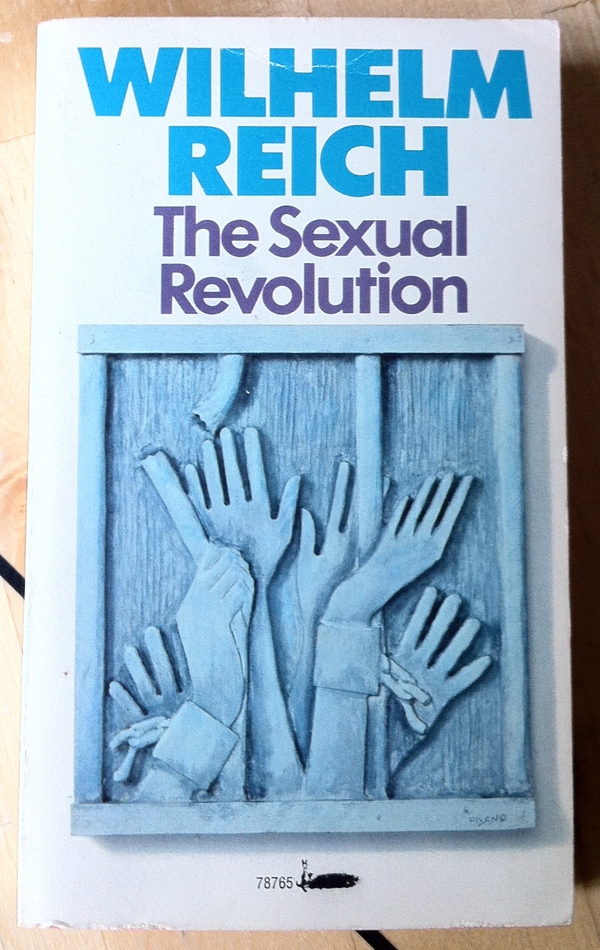
It was around this time he came to believe that “sexual energy” is an actual, tangible thing. The sex act builds up friction and the orgasm is a literal “electrical discharge,” he decided.
He began rigging patients’ nipples and genitalia with electrodes in an attempt to measure this alleged “sexual energy.” Patient’s were attached to the machine and then instructed to “masturbate, to suck each other’s nipples, to scratch, kiss, tickle, pinch, and caress one another.”19
He then threw “meat, potatoes, vegetables of all kinds, milk and eggs into a pot,” cooked them, then brought a sample to his microscope and stared at it for six hours until he saw “minuscule blue vesicles” breaking away. This, he hastily concluded, was the life force itself.20
Yes, Reich believed he had in fact discovered the origins of life, in a bowl of soup. He named these blue phenomena “bions.”
Bions then evolved into “SAPA-bions” (“sand packet bions,” as they allegedly came from heated sand). SAPA-bions radiated energy, he believed. He named this energy “orgone,” after “orgasm,” since he believed it to be sexual in nature.
He treated what he thought was a cancerous growth on his cheek with these so-called “SAPA-bions,” and then became convinced he had found the cure for cancer once it cleared up.
Concentrated orgone would be the “final solution to the cancer problem,” he wrote.
He then built a cage in his basement, filled it with these so-called “SAPA-bions,” and then took to sitting in it naked for hours on end. Eventually, he began to see “fog-like formations and bluish dots of line and light” and “[v]iolet light phenomena . . . emanat[ing] from the walls.”21
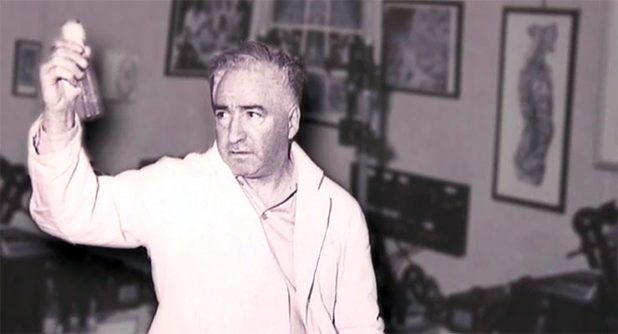
Reich was an actual, real life “mad scientist.”
Reich arrived in America in New York, which he saw as a multicultural paradise, in August of 1939.
He soon landed a teaching gig at the New School for Social Research, which was then known as the “University in Exile,” as it was home to around 200 émigrés who had fled or been expelled by the Nazis or other European nationalist regimes.
By this time, Reich had all but abandoned his political work, and was primarily focusing on his orgone energy delusion.
“I have actually discovered life,” he wrote, grandiosely. “It’s truly incredible. I, a mere nonentity, a non-academician, a sexual scoundrel in the bourgeois sense, have made the discovery of the century.”
He soon came to believe that this orgone energy was everywhere, observing it through one of his makeshift instruments in the sky, in the grass, in the pavement, in the bushes, and so on. He wrote, matter-of-factly, that we live “in the bottom of an ocean of orgone energy. The air which we breathe is in reality orgone energy.”
He then designed another “orgone accumulator,” which he believed concentrated the already omnipresent orgone sexual energy “three to five times.” From then on he built and sold or rented out these boxes, and directed patients to sit in them for varying periods of time to cure “sexual repression” and all manner of other ailments.
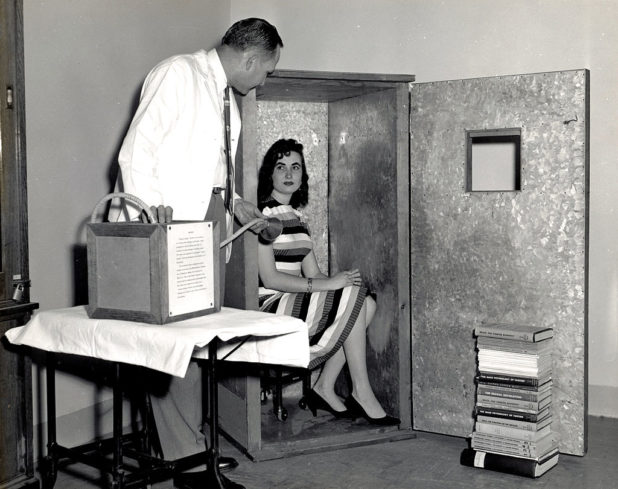
Demonstrating an early “orgone energy accumulator.”
Reich wrote fellow Jew émigré Albert Einstein about his perceived orgone discovery, hoping to win his support. “There is some reason to believe that it might be of use in the fight against the fascist plague,” read the letter.
Einstein, a dedicated Freudian and anti-fascist, obliged Reich with the opportunity to meet with him at Princeton. After a five hour meeting, skeptical but intrigued at Reich’s pitch, Einstein requested an orgone box to investigate for himself.
What caught Einstein’s attention was the fact that the air was one degree higher above and around the box, indicating some sort of energy emittance. Much to Reich’s dismay, after a few days of experiments, Einstein was able to find a simple explanation for this phenomenon. He wrote Reich that he regarded the “matter as completely solved.”
Reich, being psychologically incapable of ever admitting he was wrong, dealt with this rejection by assuming that Einstein must be lying and that he had somehow got sucked into a Communist conspiracy against Reich.
All attacks or disagreements with Reich were always blamed on a Communist conspiracy and/or the shortcomings of the opponent. Analysts who doubted his theories were sexually jealous of him and his “orgiastic potency”; colleagues and students with anything less than blind obedience were suspected of being government or Communist spies.
When journalist Mildred Edie Brady wrote an article attacking Reich and the “cult of sex and anarchy” he had birthed, Reich claimed she also must be part of the Communist conspiracy against him, and that she actually just wanted to sleep with him, labeling her “an intelligent but obviously sex hungry woman.”
“It’s obvious,” he wrote, “that Mrs. Brady believes that I am the only man who could help her to achieve an orgasm, which she so desperately needs. The tragedy is: she is not aware of her need.”22
Brady’s article, which was published in Harper’s Magazine in 1947, and a subsequent one, titled “The Strange Case of Wilhelm Reich,” published in The New Republic, were widely read, bringing Reich much negative attention. Most notably, they caught the attention of the Food and Drug Administration (FDA).
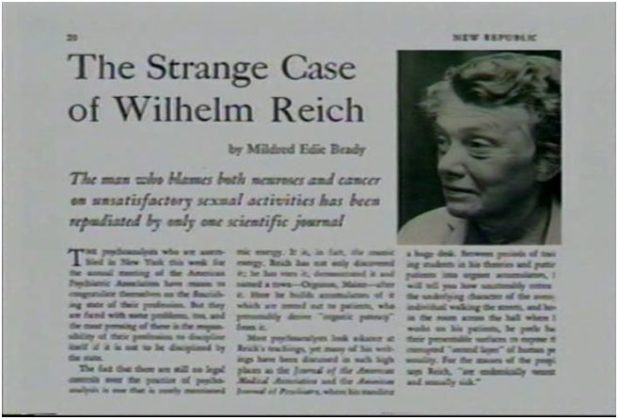
Reich was first visited by an FDA inspector in August of 1947, and remained under investigation by them, along with the FBI (whose file on Reich reached 789 pages), the Immigration and Naturalization Service (INS), and the American Medical Association (AMA), from then on.
The remainder of his life was marked by ever-increasing levels of insanity, paranoia, hallucinations, and delusions of grandeur.
Now living in a world where the nuclear bomb was a reality, Reich hoped that orgone would work as a counter against radiation sickness. In 1951 he began conducting tests, which he called the Oranur (orgonomic antinuclear radiation) experiment.
Attempting to neutralize a vial of radium with orgone, he believed it instead amplified it and erupted a “dark and dangerous mushroom cloud” over Orgonon, the large plot of land with multiple laboratories and other facilities in Rangely, Maine, where Reich was now living.
This, Reich thought, was another very significant discovery. There was a dark side to orgone, it seemed. While orgone energy promoted life, and was a positive force, this energy was the flipside, a killer, a purely negative force. He named it ‘deadly orgone energy,’ or DOR.

Orgonon, now the Wilhelm Reich Museum.
Reich came to believe that the detonation of atomic bombs had disrupted the orgone energy of the earth’s atmosphere. He began seeing dark clouds of DOR in the sky, so he built special devices to shoot concentrated orgone at the sky to break them apart. This he called “cloudbusting.”
He then came to the belief that hostile aliens were attacking the earth in orgone-powered spacecraft, maliciously spraying DOR into the atmosphere. Reich fought them back feverishly with his “cloudbuster” devices, believing himself to be the only human with the knowledge and ability to ward off the alien attacks and save the planet from imminent destruction.
In what he dubbed OROP Desert (Orgone Energy Operation in the Desert) he and his family would put a cloudbuster/spacegun in the back of a pick up truck and fight with these UFOs in the desert at nighttime – a “full-scale interplanetary battle,” he wrote in his book, Contact with Space.23
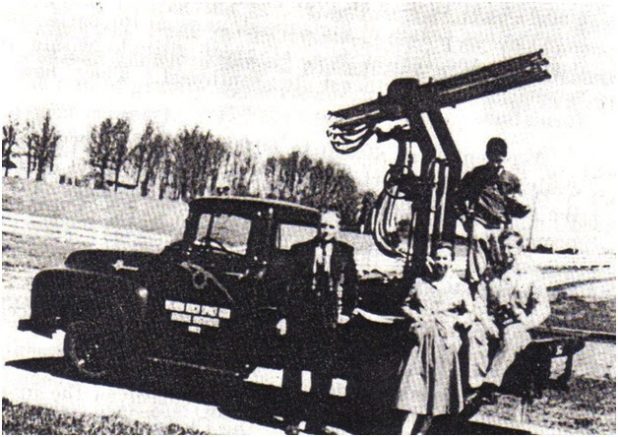
Reich with one of his pickup truck mounted cloudbusters.
In 1954 the FDA was able to secure an injunction on Reich. All of his orgone accumulators were ordered destroyed on the grounds that he was dangerously promoting them as a cure for cancer.
Reich was very uncooperative with the courts, because he thought that any concession would be akin to admitting wrongdoing, which he would never, ever do. The more he was attacked, the more it just strengthened his belief that he was a martyr for truth in the same vein as Jesus, Galileo, or any other historical genius who had been persecuted for having ideas that were ahead of their time (“A person like me comes along once every thousand years,” he once said).24
Eventually, he was sentenced to two years in prison. All known accumulators were destroyed and six tons of his literature was burned.
He was sent to Lewisburg Federal Penitentiary, where he served alongside and befriended fellow Galician-born Jew Samuel Roth (the subject of part 3).
8 months later, on November 3, 1957, he was found dead of heart failure in his cell.
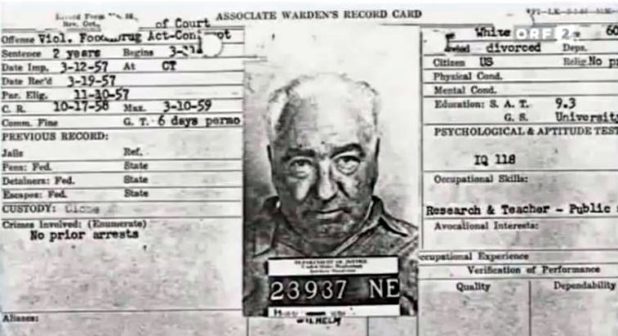
The real impact of Reich and his life’s work came after his death. His theories about sexual repression being at the root of fascism and aggression, which ironically caused him to be kicked out of the Communist Party in 1933, for having “the wrong view of fascism,” were now taken very seriously by the Jewish dominated media and Academia.
That sexual repression leads to sadism was a main theme of the Mass Psychology of Fascism (e.g. “any inhibition of natural genital gratification increases the sadistic impulses”).25 Now, post-Nuremberg, where the Nazis had been accused of sadism on a scale never before seen in human history, this theory appeared to be backed by solid evidence.
Thus, as Christopher Turner writes in his biography of Reich, Adventures in the Orgasmatron, The Mass Psychology of Fascism became “required reading for postwar intellectuals trying to understand the Holocaust.”26
During the 60s, the devastation that had been caused by WWII was still a fresh memory, and the US was embroiled in another seemingly senseless war, Vietnam. This made the “baby boomer” generation, who were living in excess wealth and luxury and packed into overcrowded colleges, ripe for the internalization of Reich’s crazy and destructive message. And the Jews pushed it on them. Hard.
The Jew Norman Mailer, more than any other, is credited with popularizing Reich’s views in America during the 60s, using his widely circulated left-wing journal.
Use of an “orgone accumulator” was made “hip” by Mailer and other counterculture figures such as Saul Bellow, Paul Goodman, Henry Miller and the “Beats” (see part 4), Woody Allen, and J.D. Salinger. Homosexual “Beat” author William S. Burroughs claimed he had once had a spontaneous orgasm while sitting in one.
All of the big “free love” sex compounds and experimental “swinger” clubs that cropped up in the 60s, such as the infamous Sandstone Retreat, and the Jew Fritz Perls’s Esalen Institute, were based on Reichian philosophies.27

Kurt Cobain sitting in one of William Burroughs’ orgone boxes.
Dagmar Herzog, in her book Sex After Fascism, writes:
Reprints of Reich’s work from the 1920s to the 1940s, initially in bootleg copies, then formally published, were circulated widely in the 1960s. No book display table on a campus was complete without Reich’s The Sexual Revolution or The Function of the Orgasm, and The Mass Psychology of Fascism was, as one contemporary reported, read just as “breathlessly.”28
In 1971, The New York Times published an article titled “Wilhelm Reich – The Psychoanalyst as Revolutionary,” where they reported on Reich’s influence on the sexual and cultural revolution that was rocking American and European universities at that time:
During the student revolts that shook many European universities in the spring of 1968, the influence of the errant psychoanalyst, Wilhelm Reich, was much in evidence. In Paris, Reichian symbols . . . were crudely painted on the walls of the Sorbonne. In Berlin, student members of free‐living‐and loving communes pelted police with softbound copies of Reich’s “The Mass Psychology of Fascism.” Reich . . . was being resurrected everywhere in Europe as a hero/saint to students demanding social reform.29
So, there we have it. We have this one blatantly insane, perverted Jew to thank – maybe more than anybody else – for the “sexual revolution.”
Another main driving force of the sexual revolution was “second-wave feminism,” which took off in the 1960s, and was also heavily influenced by Reich’s works.
In fact, much of the platform of second-wave feminism was identical to what Reich had laid out in his radical Sex-Pol doctrine, as far back as 1931 (see footnote), which was in turn similar to what had been implemented by the Jewish Marxists in the Soviet Union in the 1920s, following the Bolshevik Revolution.30
The disproportionate Jewish role in second-wave feminism will be the topic of part 7, before we move on to how the Jews have been using film as a weapon to demoralize us, in part 8.
If you enjoy this series, please consider supporting the author by purchasing a print copy.
Notes
- John Murray Cuddihy, The Ordeal of Civility: Freud, Marx, Levi-Strauss and the Jewish Struggle with Modernity, 1974, p.111
- Wilhelm Reich, Passion of Youth, 1922, p.80
- Ibid, p.6
- Ibid, p.25
- Ibid, p.29
- Ibid, p.33
- Christopher Turner, Adventures in the Orgasmatron: How the Sexual Revolution Came to America, 2011, p.80
- Ibid, p.82
- Myron Sharaf, Fury on Earth: A Biography of Wilhelm Reich, 1983, p.164
- Wilhelm Reich, The Mass Psychology of Fascism, 1933, p.25
- Karl Marx and Frederick Engels, The Communist Manifesto, 1848, p.24
- Turner, p.113
- Reich, 1933, p.48
- Ibid, p.71
- Ibid, p.87
- Turner, p.194
- Wilhelm Reich, The Sexual Revolution: Toward a Self-Governing Character Structure, 1936, p.113
- Ibid, p.62
- Turner, p.174
- Ibid., p.190
- Ibid., p.200
- Ibid., p.282-283
- Ibid., p.374
- Sharaf, p.34
- Reich, 1933, p.144
- Turner, p.152
- For a detailed description of Sandstone Retreat’s Reichian philosophy see Gay Talese, Thy Neighbor’s Wife, 1981, 186ff
- Dagmar Herzog, Sex After Fascism: Memory and Morality in Twentieth Century Germany, 2007, p.159
- The New York Times, “Wilhelm Reich – Psychoanalyst as Revolutionary,” April 18, 1971
- Sharaf, p. 157, gives Reich’s 1931 Sex-Pol seven point program as follows: “1. Free distribution of contraceptives to those who could not obtain them through normal channels; massive propaganda for birth control. 2. Abolition of laws against abortion. Provision for free abortions at public clinics; financial and medical safeguards for pregnant and nursing mothers. 3. Abolition of any legal distinctions between the married and the unmarried. Freedom of divorce. Elimination of prostitution through economic and sex-economic changes to eradicate its causes. 4. Elimination of venereal diseases by full sexual education. 5. Avoidance of neuroses and sexual problems by a life-affirmative education. Study of principles of sexual pedagogy. Establishment of therapeutic clinics. 6. Training of doctors, teachers, social workers, and so on, in all relevant matters of sexual hygiene. 7. Treatment rather than punishment for sexual offenses. Protection of children and adolescents against adult seduction.”
